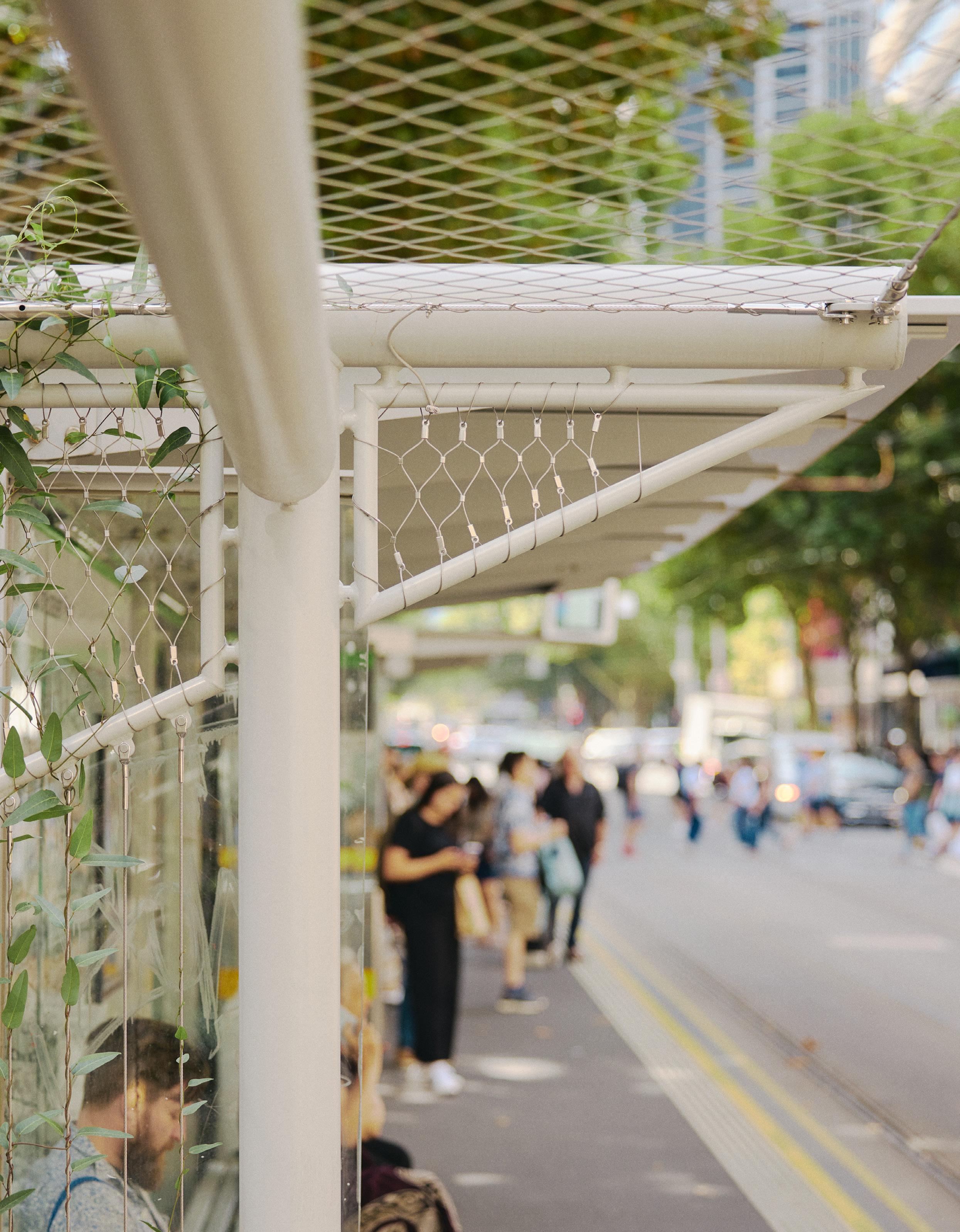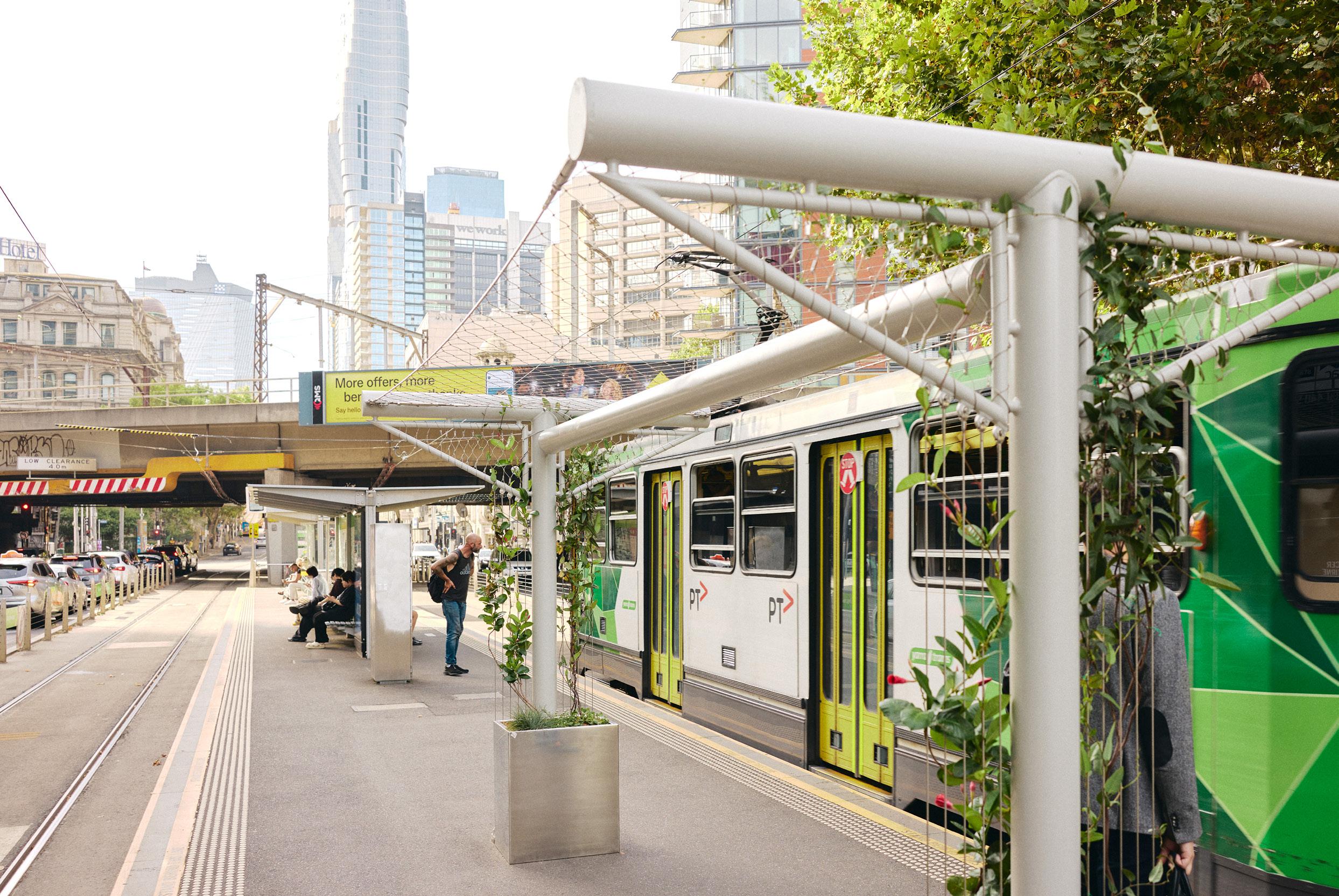Specialising in stainless steel and its applications










A visionary streetscape initiative is redefining public transport environments in Melbourne, fusing green infrastructure with the long-term performance benefits of stainless steel. Six new ‘Urban Arbours’ have been installed across central tram stops in a pilot project set to deliver cooler, cleaner, and greener city spaces.
ASSDA Member Bespoke Wire and Rope was engaged by Plant Based Building Solutions (PBBS) to assist with the design, engineering, management, and installation of the Urban Arbour structures. The concept, developed by PBBS and backed by the Department of Transport and Planning (Victoria) under the City of Melbourne’s Urban Forest Fund, is part of a broader initiative to increase canopy cover and combat urban heat.
Designed in consultation with Yarra Trams, the City of Melbourne and the Department of Transport, the Urban Arbours are visually aligned with existing tram shelters, but mark a significant step forward in terms of material performance. Yarra Trams’ prior experience with structural failures due to corrosion on powder-coated aluminium shelters highlighted the need for a more durable solution – making stainless steel the clear choice.
ASSDA literature was instrumental in demonstrating the long-term value of stainless steel to key stakeholders. Its corrosion resistance, durability in outdoor and plant-laden environments, and minimal maintenance requirements were decisive factors in its adoption.
The Urban Arbours are engineered to accommodate live greenery, withstand environmental loading from wind, earthquakes, and pedestrian impact, and support modular expansion. Their unique design also optimises installation logistics – from transport dimensions to crane operations under live tram wires – while meeting stringent regulatory and accessibility requirements.



To help bring the design to life, ASSDA Member and Accredited Fabricator SP McLean Engineering was engaged by Bespoke Wire and Rope for the structural fabrication. The frames were manufactured using grade 316 stainless steel Circular Hollow Sections (CHS), including 55 lineal metres of 33.4x3.38 CHS and 85 lineal metres of 141.3x6.55 CHS. All welds were conducted by qualified personnel following documented procedures and tested for quality assurance. A 3-coat Dulux wet spray system was applied by an Accredited Dulux Painter to blend aesthetically with the surrounding infrastructure.
Installation methodologies were carefully planned with ground-penetrating radar scans, dustless drilling, and chemical anchoring ensuring precise, non-invasive placement of footings and bolts. Each cable and mesh panel was prefabricated off-site by Bespoke Wire and Rope for efficient and accurate installation. Over 120 M12 and M16 anchor and bolt assemblies were used to erect and fasten the structure.
ASSDA Member and Accredited Fabricator Arcus Wire Group supplied the vertical trellis cables, Flexi-Mesh canopy and triangular infills. Grade 316 stainless steel was used throughout the project including:
• ~98 lineal metres of 8mm 1x19 wire rope
• ~240 lineal metres of 4mm 7x7 wire
• ~270 roll swage wire terminations
These components not only enable plant growth but also eliminate the need for excess structural steel, reducing material usage, cost, and on-site fabrication.

The lightweight cable system simplifies logistics and contributes to the arbour’s sleek and modern profile.


Designed as living, breathing structures, the Urban Arbours offer more than just shade. They support native plants that absorb CO 2, volatile organic compounds (VOCs) and particulate matter, contributing to improved air quality. The foliage also encourages biodiversity and assists in developing pollinator pathways through the use of native and flowering plant palettes.



The structures are low maintenance, requiring only periodic inspections and plant care during dry periods. Their modular design means multiple units can be joined to increase shade coverage, supporting the scalability of the project across the network.
As a showcase of sustainable urban infrastructure, this pilot project embodies the strength, longevity, and aesthetic versatility of stainless steel – setting a precedent for future city design that harmonises with nature. With early success and strong stakeholder support, the Urban Arbours are becoming a recognisable feature of Melbourne’s public transport landscape, with more installations underway across the tram network that will continue to deliver, cooler, greener, and more liveable urban spaces.

Exposure to high temperatures—where liquid water is absent—degrades metals in three primary ways:
1. Corrosion or scaling Leads to material loss and reduced functionality.
2. Loss of strength Includes immediate strength reduction and, above ~500°C, long-term creep.
3. Microstructural changes Phase transformations or the formation of harmful precipitates, which can cause embrittlement and increased corrosion risk when later exposed to water. These effects tend to be more pronounced in ferritic structures than in austenitic ones.
Austenitic stainless steels have the broadest service temperature range, from cryogenic conditions to high-hundreds of degrees Celsius. Beyond this range, high-nickel alloys become dominant.


Mechanical properties
High-temperature strength is often enhanced by precipitates that block grain movement. This can be achieved through:
• Carbides (carbon content: 0.04%–0.10%)
• Nitrides (nitrogen content: 0.10%–0.25%)
• Grain size control (smaller numbers = larger grain size):
– Stainless steel: _<7
– Nickel alloys: _<5
At medium-high temperatures, high-carbon stainless steels like 304H (0.04%–0.1% carbon) are commonly used, provided that wet corrosion resistance is not required—since chromium will be bound in carbides rather than forming protective oxides.
For applications in the mid-hundreds degrees Celsius range, 321 stainless steel (stabilised with titanium) and 347 stainless steel (stabilised with niobium) are widely used. These alloys
offer improved high-temperature strength while maintaining corrosion resistance. Both are readily weldable, though 347 consumables are recommended for welding both grades due to titanium’s high melting point.
Up to ~480°C, strength decreases steadily, but 0.2% proof strength and elongation values remain useful for design. Above this, materials experience:
• Initial distortion, followed by,
• Slow, linear creep, defined by the stress required either for 1% deformation over 10,000 hours or,
• Creep rupture strength, which is the higher stress level causing fracture within the same timeframe.
Beyond 540°C, austenitic stainless steels and nickel alloys exhibit much better strength retention than hardenable carbon and low-alloy steels.

The most common high-temperature corrosive agent is oxygen, forming chromium oxides that are significantly thicker than the passive films present at room temperature. However, at extreme temperatures, oxide layers can grow so thick that they impede chromium diffusion, allowing iron to migrate into the scale and weaken its integrity.
Increasing chromium content raises the maximum continuous operating temperature:
~900°C 301 stainless steel
~925°C 304, 321, 347 stainless steels
~1095°C 309 stainless steel
~1150°C 310 and 330 stainless steels
Low-carbon variants of 309 and 310 offer slightly lower hightemperature strength but better aqueous corrosion resistance.
When stainless steels reach their oxidation limits, high-nickel alloys are preferred. However, in sulphur-rich environments, even austenitic stainless steels can form low-melting nickel sulphides, leading to cracking at high temperatures.
In reducing conditions (e.g., environments with water vapour - even at <1% concentrations), suggested service temperatures should be reduced by 40 –60°C from the standard limits.
Adding silicon improves scale adhesion and reduces oxide growth, as seen in:
• 302B stainless steel
• 308 stainless steel
• Proprietary grades with specific alloy additions, commonly under grade designation UNS S30815.
For intermittent high-temperature exposure, thermal expansion mismatches between the oxide layer and base metal reduce service temperature limits by up to 100°C. The Pilling-Bedworth (PB) ratio quantifies this mismatch. Alloying with cerium, yttrium, lanthanum, and other reactive elements enhances scale adhesion and also mitigates sulphur-induced degradation.

Low-alloy ferritic stainless steels, such as 12% chromium grades, are commonly used in exhaust ducting and combustion-fuelled vehicle exhausts. While these alloys offer good weldability, they have relatively poor aqueous corrosion resistance and require strict composition control to prevent sensitisation cracking—particularly in welded joints and repairs.



ASSDA Member and Accredited Fabricator Aflex has played a pivotal role in supporting the seismic resilience of one of New Zealand’s most important cultural infrastructure projects – the new Archives New Zealand building in Wellington.
Engaged by Motion NZ, Aflex was tasked with designing and delivering seismic bellows assemblies for the 10-storey archival facility at the corner of Aitken and Mulgrave Streets. Built to preserve more than 12 million irreplaceable documents and cultural taonga, the new building sits on a major fault line, necessitating an innovative approach to seismic protection.

With space constraints for mechanical services and the requirement to accommodate ±500 mm axial movement in all directions (X, Y, Z), the project presented a unique and complex design challenge. Traditional bellows systems would not withstand this scale of movement while remaining stable under operational pressure.
The solution? Aflex designed bespoke multi-element, double gimbal pantograph bellows assemblies – a sophisticated, self-supporting system built to handle high-magnitude seismic movement with precision and durability.
Over 1,800kg of laser-cut plate, pipe, flanges and fittings were used in the fabrication of the bellows assemblies, with materials supplied by ASSDA Member Stirlings Performance Steels. The stainless steel sheet for
the bellows elements were supplied by ASSDA Member Midway Metals
Grade 316 stainless steel was chosen for its superior corrosion resistance and mechanical properties, delivering a projected service life exceeding 20 years. Its high elongation values are critical for the hydraulic forming of the bellows elements, ensuring proper convolution profiles without risk of failure.
Conventional bellows systems typically involve one or two elements and standard hardware such as tie rods or gimbal rings. In contrast, this project’s assemblies featured multiple bellows elements (typically eight) arranged centrally, single gimbals on each end, and pantograph arms connecting the central bellows.
The pantograph system is key to managing overall stress within the bellows assembly. As the building shifts during a seismic event, the pantograph evenly distributes movement across each bellows element, preventing overstressing of any single component and enhancing both longevity and reliability. Each arm is connected via pivot points and linked to single gimbals at either end, enabling the assemblies to accommodate multidirectional displacement.
To verify performance, Aflex used Fusion 360 software to model dynamic movement and ensure hardware
clearance, and EJMA (Expansion Joint Manufacturers Association) design calculations to assess bellows stress, spring rates, and cycle life against industry benchmarks. The result was a precision-engineered solution, unique in complexity and scale –considered among the most intricate gimbal-pantograph assemblies ever manufactured in Australia.
Aflex’s commitment to quality is embedded in every weld. Their Sydney-based facility operates with custom bellows-forming equipment and leading-edge, energy-efficient TIG and MIG welding systems. Certified to ISO 9001 and ISO 45001, Aflex employs a fully digital system across all manufacturing processes and utilises advanced welding fume extraction technology. All welding parameters are recorded digitally – including operator, weld speed, current, voltage, and filler materials – supporting a paperless workflow and ensuring full traceability and unmatched quality assurance.
Through stainless steel expertise and engineering innovation, Aflex has demonstrated the critical role of local design and fabrication capability in delivering world-class infrastructure that is safe, sustainable, and built to last.
ASSDA Member and Accredited Fabricator Leviat delivered critical expertise to realise the sculptural and award-winning design of the Phoenix Central Park Gallery in Chippendale, Sydney. A fusion of architecture and art, the private gallery of philanthropist Judith Neilson pushes structural boundaries with a façade that dimples, twists and curls in three dimensions. Behind this visually striking brickwork lies a bespoke stainless steel support system, engineered and manufactured by Leviat.
The result of a rare architectural collaboration between John Wardle Architects and Durbach Block Jaggers, and delivered by FDC Construction with brickwork specialist Favetti, the project demanded advanced technical solutions to translate the architects’ complex vision to life. Leviat’s contribution was critical in enabling the masonry skin to follow the flowing contours of the design without compromise.
To address the project’s unique requirements, Leviat supplied and fabricated the following in grade 304 stainless steel with a 2B finish:
• Over 600 special multi-adjustable wall ties
• 168m of bespoke Ancon MDC and LDC bracket angle support systems and cleats
• 2,000 Ancon SDB wall ties
• 613m of Ancon 25/14 channel and wall ties.
Masonry restraints and support systems often go unnoticed once installed, yet they are vital to a building’s structural performance.
At Phoenix Gallery, Leviat’s systems provided essential connection points between the brickwork and the structural steel and concrete frame.
Given their permanent loadbearing role and inaccessibility for maintenance or replacement, stainless steel was the only suitable material to meet the integrity, durability and performance expectations.
Stainless steel offers numerous advantages in these applications:
• High corrosion resistance, ensuring longevity in exposed environments
• High strength-to-weight ratio for secure load transfer
• Non-combustibility and hygienic surface properties
• Sustainability benefits, including up to 90% recycled content and 100% recyclability at end of life.
These properties make stainless steel an ideal solution for applications where structural reliability and longterm performance are critical.
The complexity of the Phoenix Gallery’s façade demanded close collaboration between Leviat, Favetti, and the design team. One of the most challenging aspects was the O’Connor Street façade, featuring the large ‘dimple’ detail where masonry deviated significantly from the underlying frame. Leviat responded with a bespoke multi-adjustable wall tie, specially tested at Newcastle University and tailored to mechanically engage with the brickwork, delivering both flexibility and strength.
Elsewhere, Ancon MDC and LDC angle supports were profiled to follow the façade’s undulating plan while maintaining a level bearing surface. Ancon SDB and SD25 wall ties and 25/14 channels were deployed across the gallery to restrain masonry vertically and horizontally.



The striking ‘torsion’ corner detail required another custom stainless steel solution, again designed, engineered, and manufactured by Leviat’s Sydney-based team. Their local manufacturing capabilities allowed for fast turnarounds and on-site adaptability to meet evolving project demands.
The Phoenix Gallery is a shining example of how stainless steel strengthens and protects a structure while enabling architectural creativity and innovation. Leviat’s precisionengineered systems made the project possible, enabling complex forms to be executed with confidence and long-term performance assured.
As stainless steel continues to gain recognition for its sustainability, strength, and design versatility, its use in iconic structures highlights its essential role in modern Australian construction.




THIS IS THE FINAL PRINT EDITION OF Australian Stainless


We’re evolving to bring you more stainless steel stories, insights, and inspiration –delivered straight to your inbox. Don’t miss an issue! Email us to ensure you’re on our digital subscription list: assda@assda.asn.au


More content. More impact. Same commitment to stainless.


Prochem
AUSTRALIAN STAINLESS MAGAZINE
MORE INFO: Enquiries or further information on any material presented in this publication should be directed to ASSDA:
Level 6, 200 Adelaide St, Brisbane Qld 4000 \ +61 7 3220 0722 \ assda@assda.asn.au \ assda.asn.au
EDITORIAL: Contributions of story ideas specialising in stainless steel and its applications are welcome from Members of ASSDA.
ADVERTISING: Advertise in the only publication that reaches a targeted group of 5000+ in the Australian stainless steel industry. Rates available at www.assda.asn.au.
CONTACT: Lissel Pilcher, Editor: lissel@assda.asn.au
: